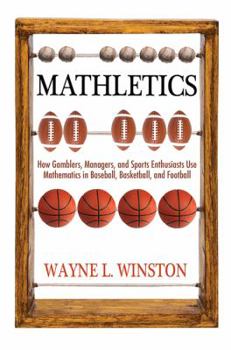Mathletics: How Gamblers, Managers, and Sports Enthusiasts Use Mathematics in Baseball, Basketball, and Football
Select Format
Select Condition 
Book Overview
How math can be used to improve performance and predict outcomes in professional sports
Format:Paperback
Language:English
ISBN:0691154589
ISBN13:9780691154589
Release Date:March 2012
Publisher:Princeton University Press
Length:392 Pages
Weight:1.28 lbs.
Dimensions:1.1" x 6.0" x 9.1"
Customer Reviews
5 ratings
Impressive!
Published by Thriftbooks.com User , 14 years ago
I had no idea as to the quality and depth of thought that has gone into this field. Winston does an excellent job, making the material reasonably understandable, interesting, and detailed - beginning at first page. Even non-mathematical issues are addressed, such as why the regular baseball season is a relatively poor predictor of playoffs - because a team's regular season depends on the performance of five starting pitchers, vs. only 3-4 during the playoffs. Bill James' thinking on baseball is there as well, and how it has been modified to handle football and basketball. Evaluating pitchers, fielders, parks, individual players in major sports, comparing players from different eras - wow!
Mathletics
Published by Thriftbooks.com User , 14 years ago
This is a great book! If you like math and sports this is the book for you.
The Mathematics and Statistics Behind Sports
Published by Thriftbooks.com User , 14 years ago
Should a basketball team down by two with seconds to go try to tie the game with a two-pointer or attempt to win it with a three? Are football teams too conservative when deciding whether to go for it on fourth down? How efficacious are sacrifice bunts in baseball when there is a man on first and no one out? In "Mathletics", Wayne Winston uses mathematics to examine these and many, many more situations in baseball, football, and basketball. The author comes to many conclusions that are against current sports conventional wisdom. Some of the other more interesting questions Winston addresses are whether Joe DiMaggio's 56-game hitting streak is the all-time greatest sports record, whether college basketball games are fixed, whether the NFL or NBA has greater parity, which sports collapses are the greatest, and whether another system to determine a college football champion would be better than the current BCS. Some of the math in the book is too advanced even for someone who took college algebra, but someone who did well in college algebra and is familiar with some concepts in statistics such as standard deviation will be able to understand much of the math the author uses to reach his conclusions. Any serious sports fan, however, would enjoy reading the book just to see the conclusions the author arrives at concerning three of America's most popular sports.
Very good survey
Published by Thriftbooks.com User , 14 years ago
The articles here present a good survey of a number of techniques for analyzing player and team performance. I only read the baseball section, because that's the only sport I'm interested in, and I found the articles to be excellent, thought-provoking summaries of a number of key areas: the Pythagorean theorem, runs created metrics, VORP, platoons, historical analyses and comparisons, and so on. The fielding analysis seemed to be just a bit spare, but that may be all that the state of the public art permits. I feel it may have underestimated the impact of poor fielding, for example by not accounting for plays (or double plays) not even attempted when the first-baseman is sub-par; or not accounting for the impact on a pitcher of a key late-inning error. But there are very good references, and the book itself collects a lot of really useful and interesting data together in fun, well-written essays.
Interesting read for math geek sports fans
Published by Thriftbooks.com User , 14 years ago
Wayne Winston addresses a myriad of topics in baseball, basketball and football via a statistics-heavy approach. There are 50 different "bites" spread out over 350 pages. There are many familiar topics for quantitative sports fans - Pythagorean theorem, platoon effects, player evaluations in different sports, and power rankings to name but a few. The entire book is moderately math heavy - over half of it is devoted to quantitative solutions using algebra, statistics and Excel worksheets (which you can find online via included addresses). If you do not enjoy the mathematical side of sports, you'll find most of the book unreadable. If you do enjoy math, stats or using quantitative approaches to gambling, this book is a nice review of most of the interesting approaches out there. The bibliography of cited books reads like a "who's who" of credible quantitative sports texts. A vast majority of the "bites" are already discussed extensively in other sources. The advantage of this book for most readers is that you can get such a diverse taste of different topics under one cover. If you are a sports modeler, the wide array of topics and approaches could help stir your own creativity. On more than one topic, I found myself saying "this assumption isn't valid!" But my making these assumptions and challenging them yourself, his approach opens up many unintended doors for the reader. For example, one bite addresses and argues that teams should pass more and run less than they do. To support this hypothesis, the book looks at a payoff chart for the yardage gained from a pass attempt versus a run attempt. The payoff chart does not consider volatility (rushing for 3 yards EVERY play is better than passing for 20 yards 1/4th of the time). It also doesn't look at the "disaster side" of passing - interceptions, quarterback fumble distribution, or greater offensive issues in a 2d and 10. Each article does make you think, which is its own payoff. My only criticism is that the writing style seemed a little clunky. If you are not fluent in math, the combination of writing style and the amount of non-math quantity may turn you off.




